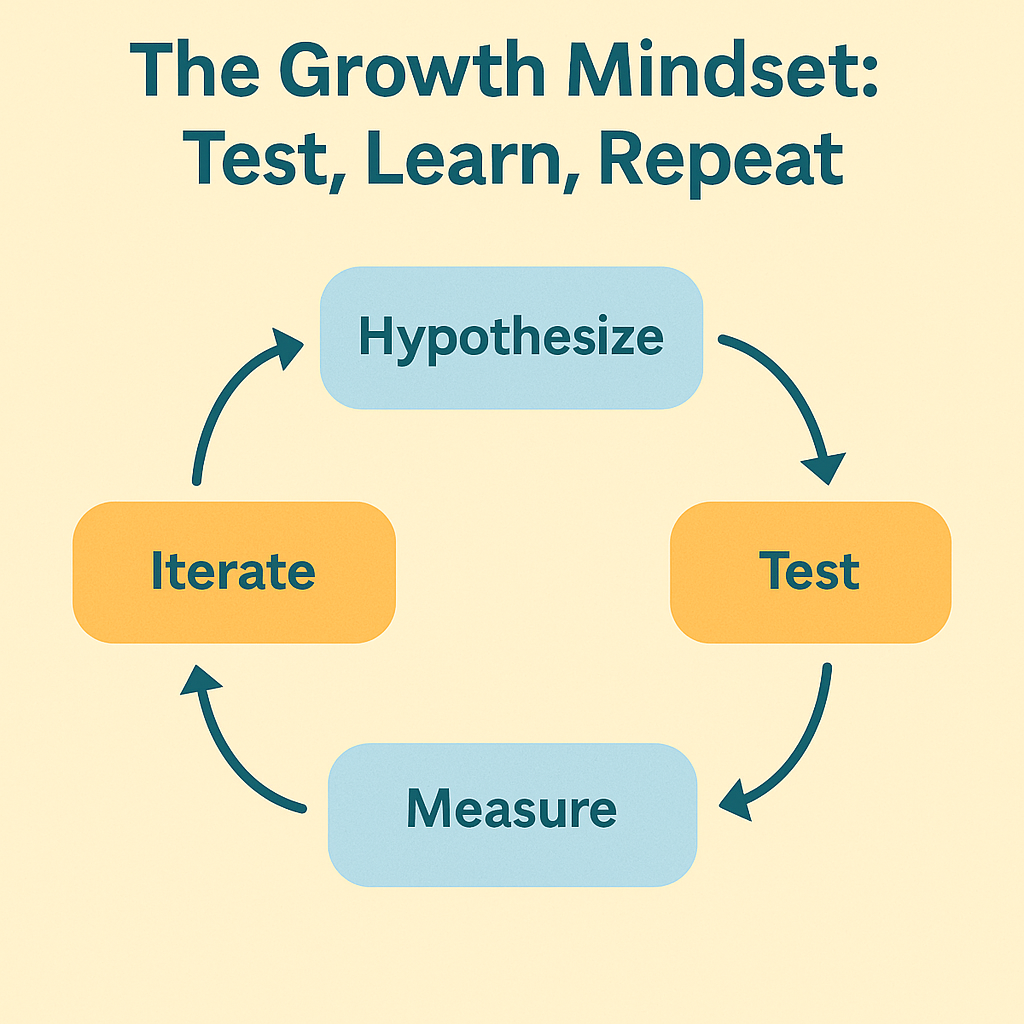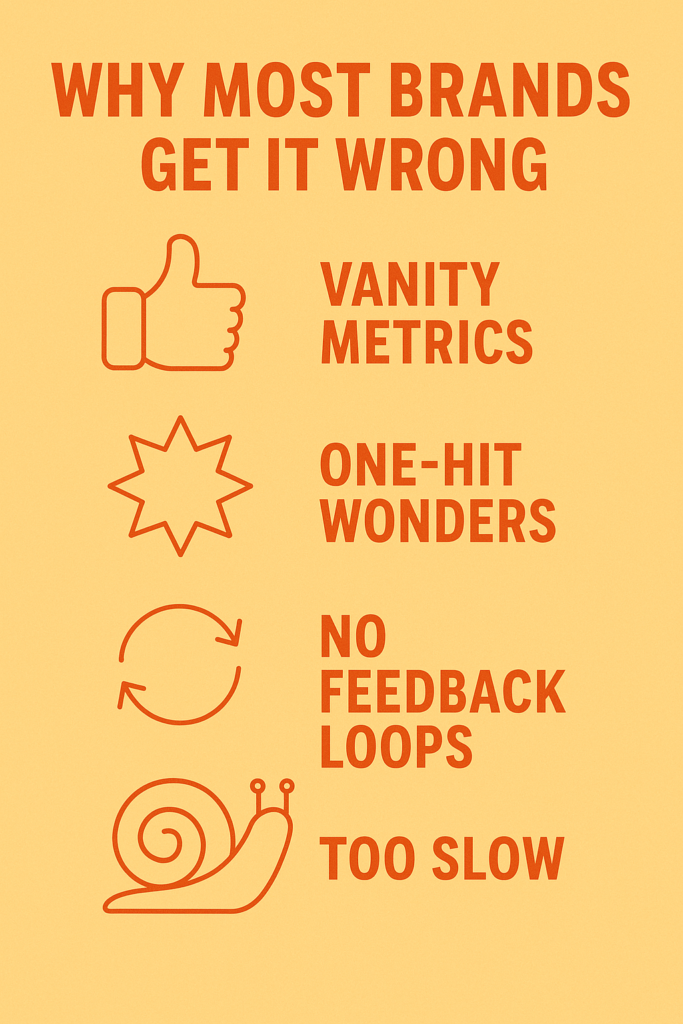
Growth Marketing 101: Why Testing and Tweaking Is the Key to Success
Ever wondered how some brands seem to go viral overnight while others burn through massive budgets without making a dent? The difference isn’t luck or timing—it’s strategy. And the game-changer here is something called growth marketing.
Unlike traditional growth marketing strategies, growth marketing isn’t about big splashes—it’s about smart data-driven marketing efforts. At its core lies a powerful, almost scientific secret weapon: experimentation and iteration. It’s the ability to test, tweak, and try again until you strike gold.
In this article, we’re not just diving into marketing campaigns and metrics. We’re exploring a mindset—a culture—where failing fast and learning faster is the real key to unlocking business growth that’s not just big, but sustainable.
Growth marketing ≠ Traditional marketing
Let’s get this straight: Growth marketing isn’t just a buzzword your LinkedIn feed keeps throwing at you. While traditional marketing might focus on brand awareness and impressions (think big-budget TV ads or splashy billboards), growth marketing campaign is obsessed with impact at every stage of the marketing funnel—from the first click to new customer retention. It doesn’t just care about how many people saw your campaign—it cares about what they did next, and how that behavior can be improved.
It’s agile. It’s scrappy. It’s data-obsessed. And it’s always asking one question:
“What can we test next to grow smarter, not harder?” It’s less about guesswork and more about gathering insights in real time. Whether it’s email marketing subject lines, targeting different marketing channels, or optimizing landing page layouts, growth marketers use every opportunity to turn the entire customer journey into a learning experience.
The growth mindset: Test, learn, repeat
At the heart of every great growth marketing manager is a scientist. Not the lab-coat kind—but the type that thrives on A/B tests, conversion rates, and hypotheses. Here’s the basic cycle:

- Hypothesize: You make an educated guess. (“Changing the CTA to ‘Get Started’ instead of ‘Buy Now’ will boost conversions.”)
- Test: You run an experiment. Carefully. With controls.
- Measure: You analyze the data. What worked? What flopped?
- Iterate: You tweak, pivot, or double down.
And then… you start again. Growth marketing is not about one giant swing. It’s about hundreds of tiny nudges, each one moving the needle bit by bit.
Real-world wins: What iteration looks like in action
Below stories underscore a universal truth: scalable growth isn’t built on a single flash of inspiration but on a foundation of thoughtful, repeatable experiments.
Dropbox’s referral program
It didn’t become legendary overnight. It was born from dozens of experiments. Free storage for sign-ups? Meh. Free storage for referring a friend? Jackpot. But even then, they didn’t stop—fine-tuning everything from email marketing copy to landing page design.

Jamie Haller’s fashion breakout
LA-based designer Jamie Haller saw a stunning 450% jump in direct-to-consumer sales from 2023 to 2024. Her secret? A blend of authentic content marketing, limited-edition drops (like her sold-out oxblood loafers), and high-touch community building—without leaning on big influencer spending.

Duolingo A/B Test
Duolingo? Their digital marketing team runs hundreds of A/B tests each month. Everything, from the color of buttons to the timing of notifications, is an experiment.

Creativity + data = Growth goldmine
Let’s bust a myth: experimentation doesn’t kill creativity—it supercharges it. In growth marketing, creative ideas don’t live in a vacuum. They live in spreadsheets, dashboards, and user journeys.
When you A/B test subject lines or landing page designs, you’re not guessing—you’re discovering what resonates. Think of it like this:
The right brain dreams. The left brain tests. Growth marketing lets them dance. Got a wild campaign idea? Great. But before blowing the budget, try it on a small scale. Use micro-campaigns. Run pre-launch TikTok ads. Build waitlists.
Watch what people actually do, not just what they say.
Why most brands get it wrong
Here’s the kicker: most brands think they’re doing growth marketing, but they’re just doing flashy marketing with a few metrics sprinkled in. The common traps?

- Vanity metrics: Chasing likes instead of lifetime value.
- One-hit wonders: Running a campaign once and calling it a success.
- No feedback loops: Not learning from failed experiments (or worse—never running any).
- Too slow: Waiting for “perfect” instead of launching MVPs.
Growth marketing doesn’t aim for perfection. It aims for momentum.
Building a culture of growth
Having one “growth hacker” on your team is insufficient. When the entire organization adopts a culture of experimenting and curiosity, real growth occurs. Here’s how to construct it:
- Celebrate experiments, not just wins: Even a failed test teaches you something.
- Encourage cross-team collaboration: Growth thrives at the intersection of product, marketing, data, and customer support.
- Invest in tools: From Mixpanel to Optimizely to Hotjar—your tech stack should enable rapid testing.
- Prioritize speed: Launch fast. Learn faster. Perfection is the enemy of growth.
Remember: growth marketing is a team sport.
Micro-experiments, macro impact
To begin, you don’t need a large budget or a full-fledged growth team. Simple, low-cost experiments can unlock valuable insights fast. The secret is to start small, maintain your curiosity, and allow actual user behavior dictate your next course of action. Today, try these simple growth experiments:
Test two versions of your email subject line.
- Change the CTA on your landing page and monitor click-through rates.
- Offer a limited-time incentive and see how it affects referrals.
- Tweak onboarding steps and see where users drop off.
Each tiny tweak is a clue—adding up to something far bigger than any single campaign.
Let’s talk about the iteration advantage
Because it reduces the risk associated with invention, iteration is your superpower. Instead of placing one giant bet, you’re hedging with data, learning what works through small, controlled tests.
Every experiment, whether it wins or fails, builds resilience and sharpens your overall strategy.
Even better, iteration unlocks compounding growth. A 5% improvement today, followed by another 5% next week, leads to exponential gains over time. Long-term brand success is the reward, and it’s similar to compound interest for ideas.
Growth marketing isn’t a tactic—It’s a philosophy
Growth marketing isn’t just a tactic you plug into a campaign—it’s a mindset that shapes how brands think, act, and grow.
Ultimately, it’s not about pursuing shortcuts or having a secret playbook. It’s about having the courage to test bold ideas and the discipline to learn from every outcome, whether a win or a flop, because a series of small, frequently undetectable trials lie at the heart of any successful brand story, viral moment, or steep growth curve.
The adjustments, experiments, and iterations that were never reported? They are the true MVPs responsible for sustained success.
Cut to the chase
So, if you’re developing a brand and hoping for that hockey-stick development curve, stop chasing viral moments or perfect campaigns. Instead, embrace the messy, thrilling, data-driven world of growth marketing. Test with courage. Never stop learning. Do this indefinitely because the brands that thrive are those that never stop changing in a world of stagnant tactics and ephemeral trends.

